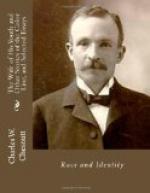The Indian element, however, looms up larger when we include Mexico and Central America in our fields of discussion. By the census of Mexico just completed, over eighty per cent of the population is composed of mixed and Indian races. The remainder is presumably of pure Spanish, or European blood, with a dash of Negro along the coast. The population is something over twelve millions, thus adding nine millions of Indians and Mestizos to be taken into account. Add several millions of similar descent in Central America, a million in Porto Rico, who are said to have an aboriginal strain, and it may safely be figured that the Indian element will be quite considerable in the future American race. Its amalgamation will involve no great difficulty, however; it has been going on peacefully in the countries south of us for several centuries, and is likely to continue along similar lines. The peculiar disposition of the American to overlook mixed blood in a foreigner will simplify the gradual absorption of these Southern races.
The real problem, then, the only hard problem in connection with the future American race, lies in the Negro element of our population. As I have said before, I believe it is destined to play its part in the formation of this new type. The process by which this will take place will be no sudden and wholesale amalgamation—a thing certainly not to be expected, and hardly to be desired. If it were held desirable, and one could imagine a government sufficiently autocratic to enforce its behests, it would be no great task to mix the races mechanically, leaving to time merely the fixing of the resultant type.
Let us for curiosity outline the process. To start with, the Negroes are already considerably mixed—many of them in large proportion, and most of them in some degree—and the white people, as I shall endeavor to show later on, are many of them slightly mixed with the Negro. But we will assume, for the sake of the argument, that the two races are absolutely pure. We will assume, too, that the laws of the whole country were as favorable to this amalgamation as the laws of most Southern States are at present against it; i.e., that it were made a misdemeanor for two white or two colored persons to marry, so long as it was possible to obtain a mate of the other race—this would be even more favorable than the Southern rule, which makes no such exception. Taking the population as one-eighth Negro, this eighth, married to an equal number of whites, would give in the next generation a population of which one-fourth would be mulattoes. Mating these in turn with white persons, the next generation would be composed one-half of quadroons, or persons one-fourth Negro. In the third generation, applying the same rule, the entire population would be composed of octoroons, or persons only one-eighth Negro, who would probably call themselves white, if by this time there remained any particular advantage in being so considered. Thus in three generations the pure whites would be entirely eliminated, and there would be no perceptible trace of the blacks left.




